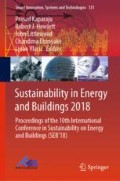Abstract
This paper investigates the simple payback period, of retrofitting a typical older existing South Australian house, that improves the star rating from 1.6 to beyond the current new build requirement of 6. The payback period varies between 6.5 and 16 years, using modest fuel escalation rates, and examines the sensitivity of energy tariffs, as well as the energy conversion efficiencies of typical space conditioning systems used in South Australia, i.e. reverse-cycle ducted air conditioning systems, and ducted gas and evaporative coolers.
Access this chapter
Tax calculation will be finalised at checkout
Purchases are for personal use only
References
Australian Bureau of Statistics: “Census of Population and Housing: Australia Revealed, 2016”, Report No. 2024.0 (2017). http://www.abs.gov.au/ausstats/abs@.nsf/mf/2024.0. Accessed 30 Jan 2018
Australian Bureau of Statistics: “Australian Social Trends, 2005 Housing Stock: Supply of Housing”, Report No. 4102.0 (2005)
Whaley, D.M., O’Leary, T., Al-Saedi, B.: Cost benefit analysis of simulated thermal energy improvements made to existing older South Australian Houses. Procedia Eng. 180, 272–281 (2017)
May, N., Griffiths, N.: Planning responsible retrofit of traditional buildings. Sustainable Traditional Buildings Alliance (STBA), UK (2015)
Cormack, L.: http://www.smh.com.au/business/consumer-affairs/australian-insulation-standards-are-not-the-most-cost-effective-research-shows-20161012-gs0xt3.htm. Accessed 30 Jan 2018
McLauchlan, C.: Impact of a Pilot Draught Sealing Program on Public Housing Air Permeability. In: Proceedings on Improving Residential Energy efficiency International Conference (IREEC), University of Wollongong, Australia (2017)
Ardente, F., Beccali, M., Cellura, M., Mistretta, M.: Energy and environmental benefits in public buildings as a result of retrofit actions. J. Renew. Sustain. Energy Rev. 15(1), 460–470 (2011)
Gamtessa, S.: An explanation of residential energy-efficiency retrofit behavior in Canada. Energy Build. 57, 155–164 (2013)
Chapman, R., Howden-Chapman, P., Viggers, H., O’Dea, D., Kennedy, M.: Retrofitting houses with insulation: a cost–benefit analysis of a randomised community trial. J. Epidemiol. Community Health 63, 271–277 (2009)
DoE, 2011, Building Energy Codes, Building Technologies Program: Air Leakage Guide. U.S Department of Energy, USA (2011)
Ambrose, M.D., Syme, M.: House Energy Efficiency Inspections project – Final Report. CSIRO Australia (2015)
MEFL: On-Ground Assessment of the Energy Efficiency Potential of Victorian Homes Report on Pilot Study. Prepared by Moreland Energy Foundation Limited for Sustainability Victoria (2010)
O’Leary, T.M., Belusko, M., Bruno, F.: Cost impacts of measures to achieve energy efficient volume housing in Australia. In: CIB, Sustainable Building Conference, Te Papa Tongarewa, Wellington, New Zealand (2010)
Belusko, M., O’Leary, T.R.: Cost analyses of measures to improve residential energy ratings to 6 Stars - Playford North Development, South Australia. Australas. J. Constr. Econ. Build. 10(1-2), 36–47 (2010)
Krstić, H., Čulo, K.: Cost benefit analysis of energy efficient family houses. WIT Trans. Ecol. Environ. 113, 191–199 (2008)
McNicol, I.: Sustainability Victoria Energy efficiency upgrade potential of existing Victorian houses. In: Proceedings of Improving Residential Energy Efficiency International Conference (IREE), Wollongong, Australia (2017)
Moore, T.: Modelling the through-life costs and benefits of detached zero (net) energy housing in Melbourne, Australia. Energy Build. 70, 463–471 (2014)
Masters, G.M.: Renewable and Efficient Electric Power Systems, 2nd edn. Wiley, Hoboken (2013)
Isaacs, T., Graham, M.: FirstRate5 User Manual © Sustainability Victoria (2016)
NatHERS National Administrator: NatHERS Software Accreditation Protocol (2012)
Belusko, M.: Personal Communication, 5 February 2018
Origin Energy Price Fact Sheet. https://www.originenergy.com.au/for-home/electricity-and-gas/pricing/energy-price-fact-sheets.html. Accessed 04 Jan 2018
Swoboda, K.: Energy prices — the story behind rising costs. https://www.aph.gov.au/About_Parliament/Parliamentary_Departments/Parliamentary_Library/pubs/BriefingBook44p/EnergyPrices. Accessed 30 Jan 2018
Harmsen, N.: Origin announces energy price hikes for customers in SA, NSW and Queensland. http://www.abc.net.au/news/2017-06-16/origin-follows-agl-in-announcing-energy-price-hike/8624348. Accessed 30 Jan 2018
Author information
Authors and Affiliations
Corresponding author
Editor information
Editors and Affiliations
Rights and permissions
Copyright information
© 2019 Springer Nature Switzerland AG
About this paper
Cite this paper
Whaley, D.M., O’Leary, T.R., Al-Saedi, B. (2019). Economic Case for Simulated Thermal Energy Improvements to Existing Older South Australian Houses. In: Kaparaju, P., Howlett, R., Littlewood, J., Ekanyake, C., Vlacic, L. (eds) Sustainability in Energy and Buildings 2018. KES-SEB 2018. Smart Innovation, Systems and Technologies, vol 131. Springer, Cham. https://doi.org/10.1007/978-3-030-04293-6_36
Download citation
DOI: https://doi.org/10.1007/978-3-030-04293-6_36
Published:
Publisher Name: Springer, Cham
Print ISBN: 978-3-030-04292-9
Online ISBN: 978-3-030-04293-6
eBook Packages: Intelligent Technologies and RoboticsIntelligent Technologies and Robotics (R0)

